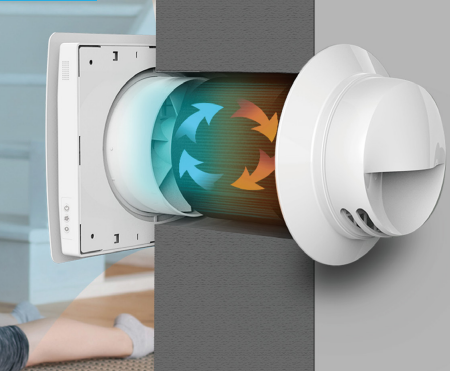How HRV Ensures a Cleaner Indoor Living Environment
The All-Inclusive Guide to the Uses of Heat Recovery Ventilation in Modern Structures
Heat Recovery Ventilation (HRV) systems represent a significant advancement in constructing modern technology (HRV Heat Recovery Ventilation). They supply a method for trading stagnant interior air with fresh outside air while minimizing power loss. This method not only enhances indoor air high quality yet additionally contributes to energy performance in both property and business buildings. Understanding the various applications and advantages of HRV can disclose its vital role in modern style and sustainability initiatives. The implications of this technology deserve discovering even more
Understanding Heat Recovery Ventilation Solutions

Lots of modern-day structures prioritize power effectiveness, comprehending warmth healing ventilation (HRV) systems is crucial for enhancing interior air high quality and reducing power usage. HRV systems function by transferring warmth from stale interior air to incoming fresh air, properly maintaining comfortable interior temperature levels while lessening power loss. These systems contain a warmth exchanger, followers, and ductwork that promote the blood circulation of air. Throughout winter months, HRV systems record and recycle heat from the outgoing air, while in summertime, they can assist cool incoming air. By continually exchanging air, HRV systems additionally reduce moisture and the concentration of interior toxins. Proper installation and upkeep of HRV systems are crucial for their effectiveness and efficiency in boosting general structure efficiency and comfort.
Advantages of Heat Recovery Ventilation
Heat recovery ventilation systems supply various advantages that improve both power performance and interior air high quality in contemporary structures. By capturing and recycling energy from exhaust air, these systems considerably decrease heating & cooling prices, resulting in reduced energy usage. Furthermore, they keep a stable flow of fresh outside air, decreasing the risk of interior air pollutants and allergens. This continual exchange aids control humidity levels, stopping mold and mildew development and guaranteeing a healthier living setting. Furthermore, HRV systems add to sustainability objectives by decreasing overall carbon impacts. Their capability to optimize ventilation without sacrificing thermal convenience makes them a beneficial addition to contemporary building layout, promoting both economic and ecological benefits.
Applications of HRV in Residential Structures
As home owners increasingly prioritize power effectiveness and indoor air top quality, the applications of warmth healing air flow (HRV) systems in domestic buildings have actually become more widespread. HRV systems are especially useful in firmly secured homes, where preserving fresh air blood over here circulation is vital for preventing dampness accumulation and indoor contaminants. They effectively move heat from outgoing stale air to inbound fresh air, minimizing power prices related to cooling and heating. Furthermore, HRVs can improve comfort levels by controling humidity and temperature level. They are likewise versatile for different property styles, including single-family homes and multi-unit structures. In general, incorporating HRV systems sustains lasting living techniques while making certain a much healthier indoor atmosphere for owners.
HRV in Business and Industrial Settings
In business and commercial setups, the application of heat recovery ventilation (HRV) systems has ended up being significantly critical for maximizing energy performance and maintaining air quality. These systems efficiently move warmth from exhaust air to inbound fresh air, decreasing the demand for added heating or cooling. This not only lowers power prices however also adds to sustainability initiatives. Industries such as manufacturing, warehousing, and office complex profit significantly from HRV systems, as they help regulate temperature level and moisture degrees, ensuring a comfortable and efficient atmosphere. Furthermore, HRV systems help in eliminating contaminants and excess moisture, boosting indoor air quality. As policies around air top quality end up being stricter, the fostering of HRV innovation is most likely to grow, making it an important component of modern-day commercial and commercial facilities.
Future Trends in Heat Recovery Ventilation Innovation

Regularly Asked Inquiries
Exactly How Does Heat Recovery Ventilation Effect Indoor Air Quality?
Heat recovery ventilation significantly enhances interior air top quality by constantly trading stagnant check this interior air with fresh outdoor air while recuperating energy. This process decreases pollutants, preserves optimal humidity degrees, and guarantees a healthier environment for occupants.
Can HRV Solutions Be Set Up in Existing Structures?
HRV systems can without a doubt be installed in existing structures. Retrofitting may require modifications to ductwork and ventilation formats, but it considerably enhances power performance and interior air quality, making it a viable option for older frameworks.
What Upkeep Is Needed for HRV Systems?

Exist Certain Climates Where HRV Is More Effective?
Heat recovery ventilation systems are particularly effective in climates with substantial temperature level differences in between seasons. These systems optimize power efficiency by recovering warm from exhaust air, making them suitable for both cool and moderately cozy environments.
How Do HRV Solutions Affect Energy Costs?
